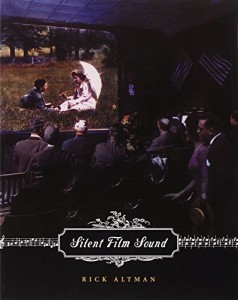Silent Film Sound
(livre en anglais)
de Rick Altman


Moyenne des votes : ![]()
| 0 | vote | |
| 0 | vote | |
| 0 | vote | |
| 0 | vote |
Votre vote : -
Description de l'ouvrage :
Because silent cinema is widely perceived as having been exactly that-silent-no one has fully examined how souns was used to accompany the films of this era. Silent Film Sound reconsiders all aspects of sound practices during the entire silent film period. Based on extensive origianl reserach and accompanied by gorgeous illustrations, the book challenges the assumptions of earlier histories of this period in film and reveals the complexity and swiftly changing nature of American silent cinema.
Contrary to received opinion, silent films were not always accompanied, nor were accompaniments uniform. Beginning with sound practices before cinema's first decade and continuing through to the more familiar sound practices of the 1920s, Rick Altman discusses the variety of sound strategies and the way early cinema exhibitors used these strategies to differentiate their products. During the nickelodeon period prior to 1910, this variety reached its zenith, with theaters often deploying half a dozen competing sound strategies-from carniva-like music in the street, automatic pianos at the rear of the theater, and small orchestras in the pit to lecturers, synchronized sound systems, and voices behind the screen. During this period, musical accompaniment had not yet begun to support the story and its emotions as it would in later years.
But in the 1910s, film sound acquiesced to the demands of the burgeoning cinema industry, who successfully argued that accompaniment should enhance film's narrative and emotional content rather than score points by burluesqiung or "kidding" the film. The large theaters and blockbuster productions of the mid-1910s provided a perfect crucible for new instruments, new music publication projects, and the development of a new style of film msuic. From that moment on, film music would become an integral part of the film rather than its adversary, and a new style of cinema sound would favor accompaniment that worked in concert with cinema story-telling. For the first time, Silent Film Sound details the ways in which these diverse intersts and industires cam together to produce an extraordinarily successful audiovisual art.
Because silent cinema is widely perceived as having been exactly that--silent--no one has fully examined how sound was used to accompany the films of this era. Silent Film Sound reconsiders all aspects of sound practices during the entire silent film period. Based on extensive original research and accompanied by gorgeous illustrations, the book challenges the assumptions of earlier histories of this period in film and reveals the complexity and swiftly changing nature of American silent cinema.
Contrary to received opinion, silent films were not always accompanied, nor were accompaniments uniform. Beginning with sound practices before cinema's first decade and continuing through to the more familiar sound practices of the 1920s, Rick Altman discusses the variety of sound strategies and the way early cinema exhibitors used these strategies to differentiate their products. During the nickelodeon period prior to 1910, this variety reached its zenith, with theaters often deploying half a dozen competing sound strategies--from carnival-like music in the street, automatic pianos at the rear of the theater, and small orchestras in the pit to lecturers, synchronized sound systems, and voices behind the screen. During this period, musical accompaniment had not yet begun to support the story and its emotions as it would in later years.
But in the 1910s, film sound acquiesced to the demands of captains of the burgeoning cinema industry, who successfully argued that accompaniment should enhance the film's narrative and emotional content rather than score points by burlesquing or "kidding" the film. The large theaters and blockbuster productions of the mid-1910s provided a perfect crucible for new instruments, new music-publication projects, and the development of a new style of film music. From that moment on, film music would become an integral part of the film rather than its adversary, and a new style of cinema sound would favor accompaniment that worked in concert with cinema storytelling. For the first time, Silent Film Sound details the ways in which these diverse interests and industries came together to produce an extraordinarily successful audiovisual art.
Voir le site internet de l'éditeur Columbia University Press
> Du même auteur :
La Comédie musicale hollywoodienne (1992)
les problèmes de genre au cinéma
de Rick Altman
Sujet : Genre > Comédie musicale
Voir plus de livres en anglais de l'auteur Rick Altman
> Sur un thème proche :
Menus for Movieland (2015)
Newspapers and the Emergence of American Film Culture 1913-1916
de Richard Abel
(en anglais)
Sujet : Cinéma muet
Americanizing the Movies and Movie-Mad Audiences (2006)
1910-1914
de Richard Abel
(en anglais)
Sujet : Cinéma muet
Nouvelles techniques et culture régionale (2005)
Les premiers temps du cinéma dans le Vaucluse (1896-1914)
Sujet : Cinéma muet
Le Cinéma au tournant du siècle (1999)
Cinema at the turn of century
Dir. Claire Dupré la Tour, André Gaudreault et Roberta Pearson
Sujet : Cinéma muet
Silent Cinema (2019)
A Guide to Study, Research and Curatorship
de Paolo Cherchi Usai
(en anglais)
Sujet : Histoire du cinéma
Histoire générale du cinéma 2 (1973)
les pionniers du cinéma 1897-1909 (de Méliès à Pathé)
Sujet : Histoire du cinéma
Nota : Un livre sur fond de couleur beige est un livre édité dans une autre langue que le français.
(*) Les boutons « Acheter chez Amazon.fr », « Commander sur Fnac.com » & « Rakuten » sont des liens affiliés. Le gestionnaire de ce site reçoit une petite commission lorsque vous achetez un livre après avoir cliqué sur le bouton. Ces (petites) commissions sont les seuls revenus de ce site qui ne contient aucune publicité, aucune insertion (ou mise en avant) payante.